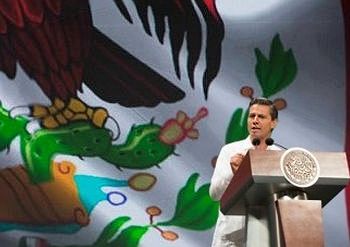Cancun, Mexico - In the midst of implementing President Enrique Peña Nieto’s structural reform agenda, Mexico is also trying to promote other sectors as a way to divert some of the frustration and opposition the reform plan has brought.
The tourism industry is the latest one to take the spotlight as the government wants Mexico to become a global player in the field. Peña Nieto just announced plans to invest $13.8 billion in tourism infrastructure during his tenure until 2018 through the National Infrastructure Program. He presented the plan at the annual "Tianguis Turistico" the most important travel trade show in Mexico, which took place in Cancun last week (May 6th-9th.)
The plan is to spend the fresh cash on, first and foremost, improving infrastructure to boost the competitiveness of the tourism sector through upgrades to airports, roads, and cruise ship terminals.
"Mexico has everything necessary to become a tourism power at the global level," president Peña Nieto told industry leaders gathered at the tourism fair.
Mexico’s tourism industry is the nation’s fifth-biggest source of revenue — after manufacturing, oil, remittance,s and foreign direct investment — and employs about 7 million people. Key projects will include the modernization of tourist airports such as Mexico City, Cancun, Guadalajara, Los Cabos, Monterrey, and Puerto Vallarta as well as the modernization of key cruise ship terminals in Puerto Vallarta and Mazatlan. Improving tourism infrastructure is a key element in Mexican government’s recently unveiled $587 billion national infrastructure plan for 2014-18.
 |
| Actor Kevin Spacey was one of the celebrities to attend this year's Tianguis Turistico held in Cancun. Mexico last week. |
The government says that 2013 was a good year for the tourism sector: almost 24 million foreign tourists travelled to Mexico, generating revenues of more than $13.8 billion, the highest ever. However, the number of visitors is very close to the one for 2012. The United States and Canada are the biggest source of international travelers to the nation, which is among the planet’s top five countries for the number of "World Heritage" sites.
Meanwhile 68 million nationals traveled within the country in 2013. Private companies are expected to invest $8.6 billion in tourism over 2014–2016, with a focus on the construction of new hotels, the renovation of existing ones, and improvements to public places. Mexico’s Board of Tourism Businesses expects the investment to create 28,000 direct jobs and 78,000 indirect jobs, according to a recent Research and Markets report.
The government hopes for the infrastructure plan – along with results from its reform agenda – will grow the economy by 1.8 percent by 2018, generating some 350,000 additional jobs each year. The revamped focus to boost the tourism industry, and further its economic importance by the end of 2018, seems to suit Mexico perfectly now as it’s being praised around the world.
And yet, the plan could derail if the country doesn’t maintain its growth rate — economists just cut their forecast for Mexico’s economic growth in 2014 to 3.01 percent, down from 3.09 percent in March and considerably lower than the governments growth forecast for this year at 3.9 percent — and if the opposition to the reform package remains fierce.
Original Story


